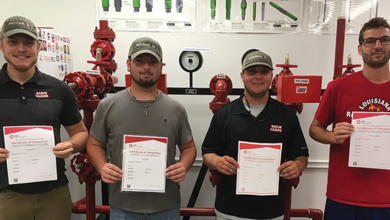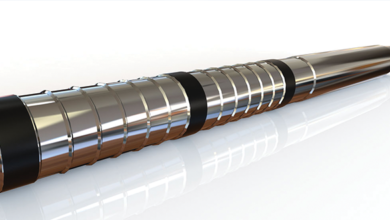Drilling and Completion Tech Digest
Diamond Offshore launching new Blockchain Drilling Service across its rig fleet
Diamond Offshore Drilling has launched its Blockchain Drilling service to drive efficiencies and enable oil and gas operators to reduce their total cost of ownership (TCO). The service provides an immutable platform for the optimization of well construction activities, including drilling-related services, material and the supply chain, both shore-based and offshore. Users can access and analyze performance from any web-accessible device for near real-time TCO management.
The cloud-based platform is scalable, and the baseline system consists of five modules to drive efficiencies and eliminate waste:
• The Supply Chain & Logistics Manager provides transparency, provenance and immutability across the entire supply chain;
• The Well Planner displays actual vs planned time-to-depth data with detailed events;
• The Spend Monitor aggregates total well construction costs versus budget;
• The Dynamic Critical Path shows real-time bottlenecks as they develop; and
• The Performance Tracker monitors operational key performance indicators.
These configurable modules can be adapted on the platform for individual well or multiwell campaigns based on operator needs. The platform will be used in the procurement stage through the construction, completion and production phases. Tracking, planning, and optimizing well(s) through each phase provides the ability to reduce spend, eliminate waste, improve processes and better align all parties needed to deliver a well successfully.
The Blockchain Drilling service, developed with Data Gumbo, will be implemented fleetwide on Diamond Offshore drilling rigs to create a Blockchain Ready Rig fleet.
“The Blockchain Drilling platform provides our customers with an economical, scalable foundation for building blockchain applications to optimize their projects while reducing TCO,” Marc Edwards, President and CEO of Diamond Offshore, said. “With the implementation of this service, together with recently released innovations, Diamond is further demonstrating our thought leadership in the offshore drilling market.”
Tubing seal solution deployed on telecoil in Azerbaijan

BiSN, which recently deployed its sealing solution in Azerbaijan, also marked the first tool setting on telecoil in its history during the project. Utilizing its tubing seal, Wel-lok M2M TS EXD, which was run and set in the well via telecoil, BiSN was able to achieve the operator’s aim of isolating a producing zone in order to perforate and produce a new zone higher in the well.
“Our tools are typically set on electric line as we need the electrical current to activate our unique thermite heater,” CEO Paul Carragher said. “However, for highly deviated wells, it is difficult to get the tools past the deviation as you rely on gravity to get them to depth – and the more deviated it is, the less gravity helps.
“Utilizing telecoil allowed us to push the tool into the well without relying on gravity, while still supplying the electricity needed to set our tool.”
This was the first time the tool has been set using this configuration.
EM&I introduces 20-year plan for hull inspections
EM&I has introduced a 20-year plan for hull inspections. Most floating offshore assets must undergo periodic surveys every 2.5 and 5 years to satisfy class society requirements.
The concept of the 20-year plan is a result of EM&I’s ODIN diverless underwater inspection in lieu of drydocking technology, which doesn’t require divers to carry out underwater hull surveys at the prescribed periods. This allows the inspections to be scheduled over a 20-year period.
Every aspect of the normal periodic surveys is covered in the 20-year plan, including critical valve inspections using ODIN access ports and specialized cameras and manipulators. The 20-year plan also includes tank inspections using EM&I’s NoMan remote camera technology, which can be done in a fraction of the time required by rope access teams.
“Our new innovations ODIN & NoMan, combined with the 20-year plan, have enabled us to cut costs by over 50% and people onboard by over 70%,” Danny Constantinis, Executive Chairman of the International Asset Integrity Specialists for EM&I, said. “All the work can be carried out while the asset is on hire, on station and in operation.”
High-temperature downhole safety valve in development
Pragma Well Technology and Pharis Energy are developing a high-temperature downhole safety valve, or downhole steam injection valve (DSIV).
Pharis is preparing a phased development plan for the Pilot field, which lies in block 21/27a on the UK Continental Shelf (UKCS), starting with a steam flood trial.
To implement steam injection offshore requires the development of a downhole safety valve that is rated for steam injection temperatures, which are in excess of 300ºC. Steam-assisted gravity drainage (SAGD) and geothermal projects have driven the industry to develop downhole components rated for these high temperatures, but steam injection has only been undertaken offshore in countries with less stringent regulations than the UKCS and where the installation of a downhole safety valve has not been required.
Pharis has decided to include a DSIV in the well design. The project will design, build and certify a pair of valves. This work has the potential to unlock the widespread application of steamflooding offshore and to enable the development of heavy oil fields, which so far have been deemed too marginal to attract investment.
Pharis estimates that steam flooding could enable the production of an additional 4 billion bbl from already discovered shallow heavy oil fields in high-quality sandstone reservoirs across the UKCS, more than the 800 million bbl that conventional recovery techniques can achieve.
Retrofit conductor-supported platform installed by jackup rig on appraisal well offshore Bahrain

2H Offshore has completed the installation of a retrofit conductor-supported platform (CSP). This enabled an appraisal well offshore Bahrain to be transitioned to production in 26-m water depth within six months of the project award. On behalf of BAPCo and Schlumberger, 2H Offshore designed a tripod CSP with boat landing that can support three surface trees, with a total work area of just 90 sq m.
Installing the platform was a challenge, as it was clamped retrospectively onto the drilled conductor under an installed surface tree. Additional conductors were driven to provide support for the CSP, enabling two potential future wells. The CSP consisted of a subsea template, a top platform, top brace structure, single deck and boat landing.
Keeping the structures small reduces transportation costs and allows the use of a jackup rig for installation, avoiding mobilization of a dedicated installation vessel. Costs were further reduced with the use of readily available standard material and local fabrication options.
The structure was installed entirely by Shelf Drilling’s Key Hawaii jackup, aided only by an observation ROV.
Field test of sand control system completed in permian
To improve and control flow in water injection wells, Tendeka has completed a field trial with a major operator for the Cascade³ sand control technology. The well screen and flow control completion system uses intrinsic check-valves built into the lower completion to prevent sand production caused by adverse flow conditions, such as back-flow, cross-flow and water-hammer, during shut-ins. It features a high-density array of non-return valves to allow for high injection rates with low back pressure.
“The overall objective of Cascade³ is to prevent the production of sand into the wellbore in water injection wells. Conventional sand control techniques are often not effective in the transient conditions that exist when injection pumps are shut down, and many injector wells can suffer a loss of injectivity due to sand fill. Deploying Cascade3 not only eliminates this failure mode, but it also means that more expensive gravel-packing solutions are not required,” Annabel Green, Tendeka’s Chief Technology Officer, said.
The three-year R&D project culminated with a field trial in a saltwater disposal well in the Permian Basin in March 2018. This consisted of unfiltered and untreated produced water and provided a suitable test lab to study valve performance. The capabilities of the technology were evaluated by simulating the effects of water-hammer and cross-flow and exposing the equipment to long-term injection in a harsh downhole environment. To observe and test the valves, the completion was configured with tubing and annulus memory gauges and a sliding sleeve to enable the assembly to be bypassed to provide a baseline performance.
During the field trial, the checking functionality of the non-return valves was demonstrated, and multiple rapid shut-in events were carried out. Data collected during the trial confirmed the operation of the system and that the non-return valves had no detrimental effect on injection performance. The well has been put on full-time water disposal duty to observe the long-term effects of injection on the valves.
Cascade3 is now scheduled for installation in three wells in Africa, and plans are in progress for its implementation for a deepwater asset in the Gulf of Mexico.
2nd Permian basin test site planned to study hydraulic fracturing efficiency
2nd Permian basin test site planned to study hydraulic fracturing efficiency
Research, development and training firm Gas Technology Institute (GTI) is leading a program on hydraulic fracturing test sites (HFTS) in the Permian Basin, bringing together government and industry to improve recovery, continue enhancing environmentally responsible methods of optimizing production and lowering costs in the Midland and Delaware Basins.
In January, GTI was awarded funding from the US Department of Energy National Energy Technology Laboratory (DOE NETL) for cost-shared research and development on hydraulic fracturing efficiency. Anadarko Petroleum and Shell plan to co-host a new field test site in the Delaware Basin, where multiple experiments to evaluate well completion, optimize design and quantify environmental impact will be carried out. Work will commence in late 2018 at an Anadarko-operated location, and other industry partners are being invited to join the project.
The new HFTS2–Delaware field test site, located in Block 55 T1 in Loving County, Texas, will feature different depths, pressures and permeability than the site of GTI’s first project, HFTS1-Midland. Each location requires specific techniques for optimal production based on local geologic complexity.
This new work will build off of HFTS1–Midland, which was also supported by DOE NETL, operators and service companies. Laredo Petroleum hosted the test site.
In September 2015, 400-plus fracture stages were completed in 11 Laredo wells in the Wolfcamp formation of the Midland portion of the Permian Basin. A first-of-a-kind through-fracture core sample was produced to document the physical properties of the fractures. Along with comprehensive data, it provided insight on how induced underground fractures spread.





